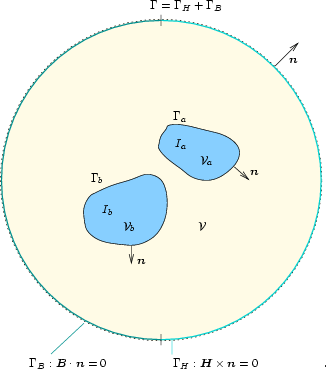Next: 7.2 Beispiel Up: 7. Induktivitätsberechnung mit dem Previous: 7. Induktivitätsberechnung mit dem
 |
Die Randbedingungen für magnetische Felder sind Vorgaben für Feldstärke
bzw. Flußdichte. Um die Eindeutigkeit des Vektorpotenzials sicherzustellen,
genügen die Vorgaben allerdings nicht. Auf dem Rand ![]() (s. Abb. 7.1)
muss zusätzlich immer die Tangential- oder die Normalkomponente des Vektorpotenzials
festgelegt werden [145]. Um eine eindeutige Lösung zu erhalten, muss
außerdem zumindest ein (beliebiger) Knoten eine Dirichlet-Bedingung
erfüllen, indem der diesem Knoten zugeordnete Funktionswert auf einen
beliebigem Wert, praktischerweise Null, gesetzt wird.
(s. Abb. 7.1)
muss zusätzlich immer die Tangential- oder die Normalkomponente des Vektorpotenzials
festgelegt werden [145]. Um eine eindeutige Lösung zu erhalten, muss
außerdem zumindest ein (beliebiger) Knoten eine Dirichlet-Bedingung
erfüllen, indem der diesem Knoten zugeordnete Funktionswert auf einen
beliebigem Wert, praktischerweise Null, gesetzt wird.
Die Oberfläche ![]() ist in zwei Teile geteilt, da besonders zwei
Randbedingungen von praktischer Bedeutung sind: Auf
ist in zwei Teile geteilt, da besonders zwei
Randbedingungen von praktischer Bedeutung sind: Auf ![]() ist die
Normalkomponente der Flußdichte vorgeschrieben, während auf
ist die
Normalkomponente der Flußdichte vorgeschrieben, während auf ![]() die Tangentialkomponente der magnetischen Feldstärke gegeben ist. Was diese
Vorgaben, (7.5) und (7.6), für das magnetische Vektorpotenzial
bedeuten, wird nun ausgeführt:
die Tangentialkomponente der magnetischen Feldstärke gegeben ist. Was diese
Vorgaben, (7.5) und (7.6), für das magnetische Vektorpotenzial
bedeuten, wird nun ausgeführt:
Diese beiden Randbedingungen werden mit dem magnetischen Vektorpotenzial folgendermaßen formuliert
und stellt somit auch die Eindeutigkeit von
![]() sicher.
Diese Dirichlet-Randbedingung ist durch die Vorgabe der
Tangentialkomponente auf der Oberfläche
sicher.
Diese Dirichlet-Randbedingung ist durch die Vorgabe der
Tangentialkomponente auf der Oberfläche ![]() gekennzeichnet.
Homogene Dirichlet-Randbedingungen (
gekennzeichnet.
Homogene Dirichlet-Randbedingungen (
![]() ), entsprechend
(7.9), bedeuten bei unendlich langer, gerader
Grenze
), entsprechend
(7.9), bedeuten bei unendlich langer, gerader
Grenze ![]() (s. Abb. 7.2) eine antisymmetrische Spiegelung von
Quellenstromdichten. Es dürfen somit in der Symmetrieebene nur
Normalkomponenten von Quellenströmen auftreten, das resultierende Magnetfeld
verläuft entsprechend (7.5) tangential.
(s. Abb. 7.2) eine antisymmetrische Spiegelung von
Quellenstromdichten. Es dürfen somit in der Symmetrieebene nur
Normalkomponenten von Quellenströmen auftreten, das resultierende Magnetfeld
verläuft entsprechend (7.5) tangential.
Eine ideal leitfähige (supraleitende) Oberfläche kann durch eine
homogene Dirichlet-Randbedingung für das Vektorpotenzial
![]() repräsentiert werden. Wenn ein magnetisches Feld außerhalb des Leiters
existiert, werden Oberflächenströme derart induziert, dass das Innere des
Leiters feldfrei bleibt.
repräsentiert werden. Wenn ein magnetisches Feld außerhalb des Leiters
existiert, werden Oberflächenströme derart induziert, dass das Innere des
Leiters feldfrei bleibt.
Homogene Neumannsche Randbedingungen sind durch (7.8)
gegeben und haben bei unendlich langer, gerader Grenze (siehe Abb. 7.3)
eine symmetrische Spiegelung der Quellenstromdichten zur Folge. In der
Symmetrieebene dürfen somit nur tangentiale Quellenströme fließen, das
Magnetfeld verläuft senkrecht zur Begrenzungsfläche.
Um das Vektorpotenzial eindeutig zu machen, ist es notwendig, dessen
Divergenz und auf der Oberfläche ![]() des Bereichs
des Bereichs ![]() , entweder
seine Normal- oder Tangentialkomponente zu definieren [115].
Da die Tangentialkomponente von
, entweder
seine Normal- oder Tangentialkomponente zu definieren [115].
Da die Tangentialkomponente von
![]() auf der Oberfläche
auf der Oberfläche
![]() schon vorgegeben wurde, ist es naheliegend seine
Normalkomponente auf
schon vorgegeben wurde, ist es naheliegend seine
Normalkomponente auf ![]() festzulegen. Man erreicht
dies durch die Einführung der zusätzlichen Randbedingung [146]
festzulegen. Man erreicht
dies durch die Einführung der zusätzlichen Randbedingung [146]
Zusammenfassend werden noch einmal mögliche Bedingungen angeführt, die ein eindeutiges Vektorpotenzial sicherstellen [115]:
Die hier angegebenen Randbedingungen führen zu einer Verkoppelung der drei
Gleichungssysteme für jede Komponente von
![]() . Die verfolgte
Strategie bevorzugt deshalb als Randbedingung am fernen Rand
. Die verfolgte
Strategie bevorzugt deshalb als Randbedingung am fernen Rand
![]() vorzugeben, da dies zu drei entkoppelten Poisson-Gleichungen führt.
Das Simulationsgebiet muss ohnehin groß genug sein, damit das Feld nicht
verzerrt wird.
vorzugeben, da dies zu drei entkoppelten Poisson-Gleichungen führt.
Das Simulationsgebiet muss ohnehin groß genug sein, damit das Feld nicht
verzerrt wird.
Die Ausnutzung der Symmetrie durch die entsprechenden homogenen Randbedingungen kann den Berechnungsaufwand eines Problems wesentlich reduzieren. Sind jedoch Randbedingungen vorzugeben, wo Spiegelungen unerwünscht sind, so muss deren Einfluss gering gehalten werden. Deshalb wird der Rand weit genug vom eigentlich interessierenden Feldgebiet weggerückt [147].